#i really recommend a read
Text
I got too deep into the Schema Theory while writing the paper for one of my exams and it got me thinking about Apollo's coping mechanisms yk
Basically the gist of this theory is that, in the eventuality that their primary needs are not satisfied during their formative years, a child might develop a bunch of different behavioural schemes in their adult life (which are too many to be listed here oh my god) that are a direct reflection of how the parent failed them during childhood
For example, one of these schemes is emotional deprivation, which is a person's tendency to emotionally distance themselves from other people due to the fact that they believe they won't be able to comfort them, and it's a scheme that's formed due to the guardian not satisfying the child's emotional needs. Basically it's formed through a "If my parent couldn't do it, then how could others?" sort of mentality
Another one, which I believe is very relevant here, is the sense of failure, which originates due to the guardian's immensely overbearing nature and the continuous dissatisfaction with the child's efforts. As an adult, the child in question believes that they're inept at everything, even if evidence points to the contrary, because of the fundamental belief that they hold that they're a failure
(Does it remind you of anyone?)
Now, these schemes tend to go hand in hand with modes, which are essentially coping mechanisms that the person uses to deal with whatever life throws at them and whatever negative emotion these schemes bring on. One of these modes is the *squints* scheme overcompensation? Anyway what it says on the article I got the info from is that basically people who use this coping mechanism tend to do the opposite of what their behavioural scheme tells them to do. If they're ashamed, they put down others. If they feel like a failure, they boast. (Again. Who does this sound like.)
AT FIRST it seems like a good coping mechanism but it's actually not, because the overcompensation leads to this vicious cycle where the more a person overcompensates, the more the scheme worsens. In Apollo's case, the scheme we're examining here is his sense of failure; in his overcompensation mode, to avoid feeling incompetent he tries to constantly put himself in the spotlight, drawing attention to his talents. However, he does it in such a ridiculous way (perhaps actually in some form of self-sabotage?) that the people around him insult those talents, call him a failure, and thus worsen his feeling of worthlessness.
(This might be tied to the punitive scheme as well, maybe? Considering how keen Zeus was on punishment, Apollo might've developed this scheme as a result, though over the centuries it could've shifted its focus from everyone to just him idk. The change between "I'm punishing everything and everyone for being so stupid, even my own son + this Ptolemaic god who breathed wrong in my direction" to "Actually I'm chill" seems pretty suspicious to me tbh)
ANYWAY all of this is to say that everything he does is so intrinsically tied to the damage Zeus did to him that it hurts. All his behaviours all his coping mechanisms. Everything
The arrogance is not just a façade he built over the years to hide his feeling of unhappiness and guilt!! It's quite literally an abuse response!!!!
And yeah maybe Leto was the one who spent the most time with him and Artemis and who took the most care of them so technically she should be considered his figure of attachment instead of Zeus but then again. How much time did Apollo spend beside her compared to the time he spent at Zeus' side, after the twins became Olympians? What do a few moments with her in a year do against entire centuries with him?
Leto's influence never really mattered. He was doomed since the beginning
#or rather not doomed just. really sad. thank god he's got friends now#shamelessly wrote this so i can memorize it better#it's a very fascinating theory though#i really recommend a read#btw some of this might be wrong bc a) i study medicine and not psychology and b) it's 4 am#actually almost 6? god i'm sleep deprived#anyway please don't mind it#it was just for funziessss!!!#trials of apollo#lonely thoughts#might delete later idk i'll see if this still makes sense in a few hours
100 notes
·
View notes
Text
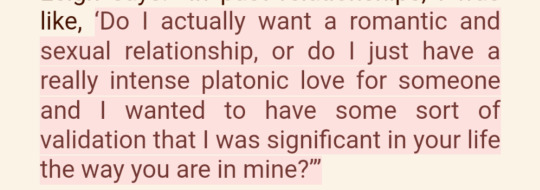
been going a little bit insane about this sentence from Ace by Angela Chen for the past week
#replace this with any other type of significant relationship too#also! this book actually rules btw i really recommend it#i didnt read it when it first cane out bc i was like. well i am already pretty familiar with asexuality and not rly interested in 101 stuff#but it turns out it doesnt feel 101-y at all its a super awesome piece of queer theory and also chen has Good opinions#and not weird watered down ones that i am sometimes wary of in aspec communities (frankly especially ace ones)#i think maybe if more people approached asexuality the way chen does (including and maybe even especially ace people)#i would be more inclined to still ID as ace#but anyways!#aro#aromantic#<- tag selections that reflect how i personally engage with this quote#also#described in alt text#also also#j tag#:/#aro media
8K notes
·
View notes
Text

Do you like sci-fi and indie animation? Check out Monkey Wrench!
#monkey wrench#digital art#This series is very delightful and also in need of more attention!#Usually I would ramble about why love it - however I am going to go a little off the rails and talk about something else.#Namely that this is a gift for a very dear friend who loves this series a lot! One of my favourite people of all time!#Thank you for so many things. For keeping me going when times are dark. For sticking by in the hard times.#Thank you for the incredible soup and the fun moments! For the great recommendations on series.#I sometimes feel like I should thank the universe for letting our paths cross when they did.#It feels cheesy to say all this but I really am such a better person because of you.#Thank you for reading all my silly comics even though you have *no* idea what is going on in them. It means a lot.#My gift of a silly doodle and hopefully getting a few people to check out this show is not adequate to express my gratitude.#But hey - we've got the rest of our lives to keep saying thank you.#Love you lots mate. Can't say it enough B'*)
513 notes
·
View notes
Text
Me: hm, I want something to put on the TV as background noise... Huh. Looks like YouTube is recommending something called The Last Unicorn. That's perfect, it's probably some old shitty animation that has aged poorly! I can watch it ironically!
Me, 2 hours later as the credits roll: *crying, cheering, buying the book, composing the songs*
Me, 2 weeks later: So I have compiled all of the quotes from the book that I think could make good tattoos, and also, HOW HAVE I NEVER LEARNED ABOUT HOW THE LAST UNICORN FUCKING SLAPS??? This gay-ass little fairytale fed my soul! Watered my crops! Transed my gender! Can't believe I heard of this story from youtube recommendations, of all places!!
#original#the last unicorn#tlu#peter s beagle#molly gru#schmendrick#schmendrick the magician#two of my favorite characters in anything right there in the center of the story! and I'm glad I saw the film first!#my reading ability has diminished due to trauma disability etc. but it seems like having a visual reference actually really helped!#no wonder i only ever want to read fan fic! turns out reading is not actually Superior to other types of Storytelling. it's just different.#to say otherwise is snobbishness I have been eminently guilty of in my life!#but like it is easier for me to consume tv and movies and that is fine actually. also that's why I'm doing a graphic novel lol#because i wanted to make something i would actually be able to read if i found it at a library. altho the audio book IS gonna be bomb#the audiobook is for visually impaired readers and anyone who wants or needs it! accessible stories for everyone! yeah!!#my gender was already transed but now I've gained an ADDITIONAL gender! which one? I'll never tell 😘#i am so powerful i have so much fuckin gender. my wife has no gender. and she is equally as powerful.#and also she has STUDIED THE BLADE#mostly zoro's blades from One Piece#normally YouTube recommends me shit movies like idiocracy or smth this is like if every day ur cat brought you a piece of rotten food and#then one day it brings you a BEAUTIFULLY ANIMATED TALE FEATURING MY BELOVED TWINK FUCK-UP WIZARD FRIEND AND MY ALL-TIME HOMEGIRL MOLLY GRU#and also it's soft and beautiful and funny and fucking weird!! i wrote melodies to the songs in the books on my ukulele
3K notes
·
View notes
Text
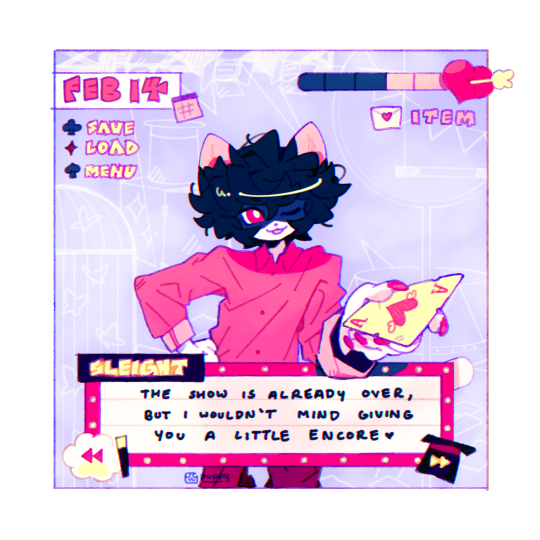
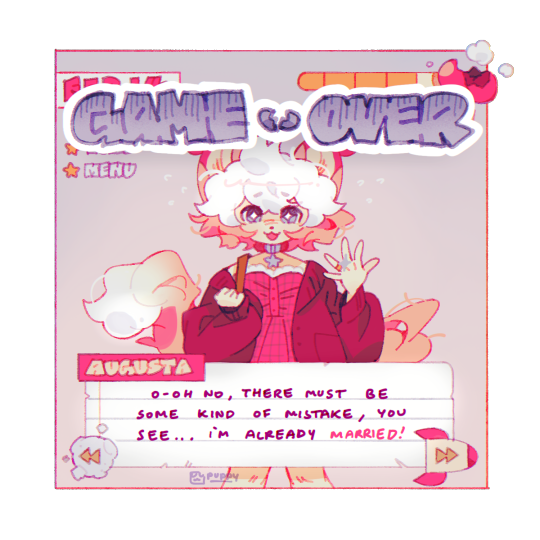
happy valentines day <3 i wanted to do more, but sadly i only had enough time to complete these two

please also don't forget Rafah is under attack and urgently needs help. you can buy esims, check the BDS boycott list, click the daily donation button and email your representatives (USA).
there will also be a global strike february 18 - 24.
#the proceeds from the daily button goes to UNRWA but id also recommend palestine childrens relief fund & red crescent#theyre doing on the ground work but i havent heard if theyre able to reach people in Rafah so ive linked other resources for now#im also trying to see if i can make time to do drawings for esims since i cant send money myself#i have my reading week in 2 weeks so i can try to do as much as i can while managing school and energy levels#im really sorry to put this on my valentines day post but it feels too dismissive to leave it on its own post where it wont be seen#my art#myart#my oc#oc#valentines day#sleight#augusta#fur#furry#furry art#doodles#sona#puppysona#palestine#free palestine#bright colors#cw bright colors#eyestrain#cw eyestrain#eye strain
594 notes
·
View notes
Text
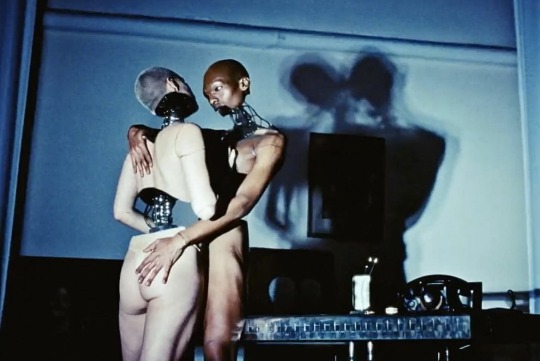
Makeup and prosthetics by Isamaya Ffrench, VFX by Mathematic.tv for JUSTICE
#isamayaffrench#isamaya ffrench#mathematic.tv#etjusticepourtous#there’s so much more credits missing#I really recommend reading through the credits hence the link
366 notes
·
View notes
Text
Tw: blood (just a bit)
HAPPY ONE YEAR ANNIVERSARY! :D to the wondeful fic by @bubbiethesaur

I cannot recommend this fic enought, it’s so well written and has got me in a choke hold (Lra sun my beloved<33)
(Ok now I’m sprinting to the new chap)
#my art#Lra#Lra sun#Lra moon#Lra eclipse#long road ahead#ok time to go grazy in the tags#GOD I LOVE THIS FIC SM#I’VE BEEN WANTINO GO MAKE FANARTO FOR LIKE FOREVER#and the new chapter just came out?#Literally made my day#I really recommend reading the tags carefully if you want to read it#but it’s so good#dca au
349 notes
·
View notes
Text

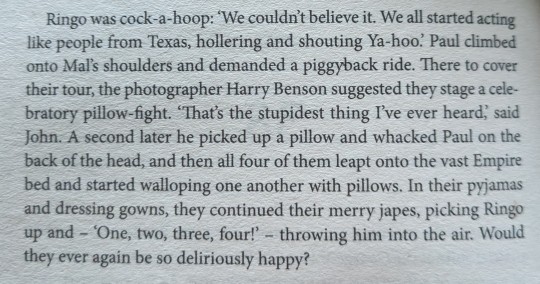
They were so silly, oh my god
#the beatles#this is from 'one two three four' btw I really recommend it if you want to read a very detailed history of the beatles#misha talks
228 notes
·
View notes
Text

the first and lowest sphere of paradise manifests the inconstant in faith, just as the moon is inconstant in its phases.
#ultrakill#gabriel#been thinking about this ever since i made the post about it#gabriel contemplates on the moon!!! the sphere of broken vows!!!#it's there that he questions what his service meant and his duties to god!!!!#quote is also taken from the ciardi version#i've read it twice and really recommend it!#it's great for keeping the rhyming scheme and provides a lot of footnotes vital to understanding the comedy#doodle tag
258 notes
·
View notes
Text

"Who's your friend, MK?"
INSPIRED BY THE FIC:
https://archiveofourown.org/works/46162438/chapters/116212117
Which, if you 'haven't read yet- why not?? go read it now!! It's literally so good, its so good- had me crying- LIKE. I WANNA FIGHT WUKONG FROM THIS FIC SOOOO BAD but at the same time,,, i wanna hug him and bring him nice things and make sure he's safe and happy! The author writes so amazingly and aaaah! the pain!!!!
#N E WAY#i wanted to do it in a sorta crayon style#so it had a sort of 'through the lenses of a child' kind of look - idk if it came out well#but i do like the style! i saw an artist at comic con + it looked like they went over their art with a crayon effect which i really liked#but i got a bit of the way through and went 'hm. what if i just did it all crayon.' whICH I ENJOYED SO SHRUGS#i haven't read the newest chapter yet! but as soon as i post this im going to#and then prolly slide into Smiles dm's and cry - ive been told it has angst!#its such a good fic tho#100% recommend it#along with their other fic - Taken#which is also really good i have a lil drawing planned for that oneee#hint hint its about the name line - 'A name is the first gift you are given' cause it made me cry a little#shadowpeach#MK#macaque#six eared macaque#sun wukong#lmk#lego monkie kid#monkie kid#the day the world eclipsed#fic inspired#my art#smudged art#artist on tumblr#SWK#qi xiaotian#lmk fanart#lmk shadowpeach
1K notes
·
View notes
Text
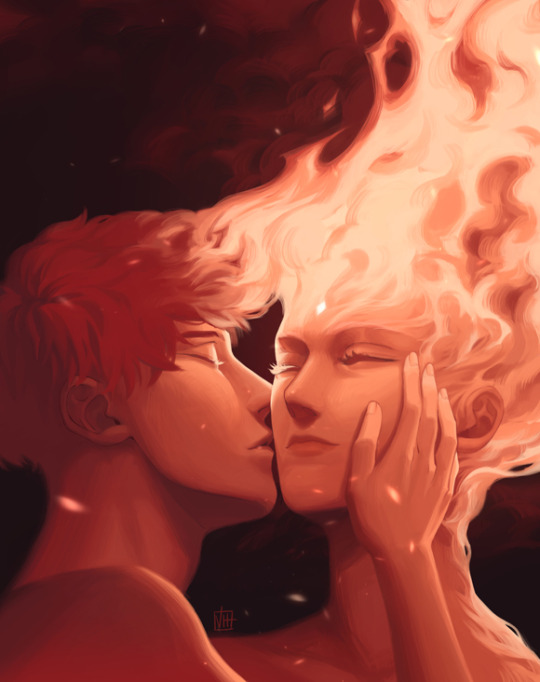
"Sakura had never felt so validated in her love until she met a man made better by her burning."
The Void Between Fireflies by @renaerys
#sasosaku#sakura haruno#sasori#akasuna no sasori#this one was inspired by both jo's beautiful fic and a sasosaku month prompt “like fire”#jo is super duper talented and i highly recommend checking out her stuff#she is one of the few who truly nails sasori's characterization in my opinion#another fun fact is that she is partially responsible for the fact that i speak english#her stuff was the catalyst that really got me studying english back in the day#i read zero hour while having a dictionary open in front of me lmao those really were the days#anyways i'm rambling#my art
310 notes
·
View notes
Text
A Quick History of BL
As someone who wrote a thesis on this very subject a few years ago, here is the short version of how BL has evolved throughout the years. For the new comers ❤
a minute of silence for the original form of this post that tumblr decied to not save right after I saved it
I am going to go with a chronological approach. Unfortunately, I cannot put everything in one post so if there’s any questions about this or that aspect of the history of BL that you want to know and it’s not talked about here, you are welcome to ask me directly :)
Context and influences - Japan in the 60′s
Before the US forced Japan to open its borders to the outside world in the 1800s, homosexual practices were common place between budist monks, samurais and kabuki actors. During the Edo period (1600s to 1800s) there was a very rich amount of poetry, art, books (such as Nanshoku Okagami (The Great Mirror of Male Love) by Ihara Saikaku) and codes of conduct about how to have a good master/aprentice relationship, kinda like the greeks if you know what I mean. However, with the arrival of western influences, in order to become a more “civilized” country, it was all put in the closet.
Yet, in the 60′s Japan started to pick it up again through literature about young androginous beautiful boys (aka bishounen). On one hand, in 1961, the novel Koibitotachi no Mori (A Lover’s Forest) by Mari Mori was published. It tells the story of a young and beautiful 19 year old worker and a half french half japanese aristocrat, and their tragic romance. On the other hand, Taruho Inagaki wrote Shounen ai no Bigaku (The esthetics of boy-love), an essay on aesthetic eroticism (of which he wrote a lot of). All this was know as Tanbi (lit. aesthetic) literature. It generally refered to literature with implied homosexuality and homoeroticism such as works by Oscar Wilde, Jean Cocteau, etc. And of course, Mori and Inagaki.
In chinese tanbi is read as danmei (term used to refer to BL novels in china today, ie: The Untamed it’s all connected friends).
From the birth of Shonen Ai to Yaoi - 70′s to the late 80′s
Around the beginning of the 70′s, shoujo was being revolutionized by the Year 24 Group, a generation of women manga authors (mangaka) who started to explore new themes. Among them, their interest in tanbi gave birth to a new subgenre: Shounen ai.
Their most known manga were:
Kaze to Ki no Uta (The Ballad of the Wind and Trees) by Keiko Takemiya, and
Toma no Shinzo (The Heart of Thomas) by Moto Hagio
Their stories are characterized by having suffering eurpoean bishounen in boarding schools, living an idealized perfect love (meaning passionate) that, despite the tragic end of one of them, lives forever in the other.
As this genre starts getting popular, more and more fans of these stories start making their own self published manga, aka doujinshi, of the genre. It is around this time that the term Yaoi is coined. Meaning “YAma nashi, Ochi nashi, Imi nashi” (no climax, no fall, no meaning). Basically PWP fanfiction, for the most part. Doujinshis could be considered an equivalent of fanfiction in manga form. It is also here that the term Fujoshi (aka Rotten Girl, for liking rotten things) starts being used to refer to women readers of yaoi.
With this rise in popularity come the start of the commercialization of the genre. Which meant the publication of magazines dedicated solely to yaoi/shonen ai/BL. The most popular yaoi manga magazine at the time was June. The common trait of their stories being the therapeutic power of the love between the mains. The traumatized character would heal throught this newfound love.
Most of the stories at this time happened in the West (Europe or the States) as the exploration of these dark themes intertwined with homosexual romance and homoeroticism still feel safer to explore as a foreign concept. One example would be Banana Fish (1985).
Commercialization and Yaoi Ronso - 90′s
As more publishing houses pick the genre up, the term Boys Love is used to include every type of manga about homosexuality made for women.
The increasing amount of BL series sees a changes in its themes:
the start of the “gay for you” trope where one mantains their heterosexuality despite being in a homsexual relationship,
the uke/seme dynamic (mirroring hetero realtionships) also relating to physical appearence (one being more feminine, the other being more masculine),
the use of rape as an act love (sexual violence has always been present but here it becomes a staple),
anal sex as the only type of sex,
older and more masculine men start to appear
they now happen in Japan
Good examples of the presence of these themes in manga are Gravitation (1996) or Yatteranneeze (1995).
However in 1992, Masaki Sato (a gay activist/drag queen) wrote a letter in a small scale feminist magazine attacking yaoi and pointing out how it “represented a kind of misappropriation or distortion of gay life that impacted negatively upon Japanese gay men”. The female readers of yaoi responded, defending the genre as a means to escape gender roles and explore sexual themes that was never meant to represent the realities of gay men. This is know as the Yaoi Ronso (Yaoi Debates).
The debate ended with both sides understanding more of each other, with mangakas starting to include queer views in their works. It also started the academic reasearch of BL.
Yet, it is a debate that has been restarted more than once, as it is still relevant despite the evolution of the genre.
more on this on another post
Globalization and coining of BL - 2000′s
By the beginning of the 2000s BL is being sold all over the world (like all manga), and has become a stable industry. We could say it has finally become it’s own genre.
Some of the most well known manga series, to us (in the west), of the time are:
Junjou Romantica 2002
Koi Suru Boukun 2004
Love Pistols 2004
Haru wo Daiteita 1999
all of these have anime adaptations for the curious ones
We also start seeing short anime adaptations or special episodes of the most popular series, with questionable themes, such as: adoptive father x adoptive son (Papa to Kiss in the Dark 2005), father x son’s friend (Kirepapa 2008), etc...
However the themes remain more or less the same. Junjou Romantica’s love story starts with a non-con sex scene by the older one (masc, seme) to the younger one (more feminine, uke) addressed years later in the manga btw. Koi Suru Boukun’s love story is triggered by aphrodisiacs and rape. They’re still very present in the stories but slowly going away. A mangaka that represents this era could be Natsume Isaku (Candy Color Paradox 2010).
Change is slow in Japan. Even though the voices of LGBT+ people started to be taken into account in the genre it is not until later that we see it reflect in the mangas themselves. However, we can already see the start of this in Doukyusei (Classmates) (2006) by Asumiko Nakamura. Also Kinou Nani Tabeta? (2007) which is actually part of a more mature genre: Seinen.
It is my personal (subjective) theory that the BL of this era was the one that got popular outside of Japan, which is why we see lots of references to the themes, tropes and dynamics of this time in today’s BL series.
The LGBTzation of BL and the rise of webtoons - 2010′s to 2020′s
Slowly but surely LGBT characters and themes enter the scene of BL. Existing simultaneously with the previous tropes and themes, we start seeing a shift in these stories. We now see:
characters that identify as gay or some type of queer
discussions about homophobia
more mature themes about life and romance
At the same time as we get the usual love stories with the usual themes, a new trend starts to take over. And we get simultaneously, cute, sometimes questionable but light love stories:
Love Stage 2010
Ashita wa Docchi da! 2011
Kieta Hatsukoi 2019
More profound stories and darker or more complex themes:
Blue Sky Complex 2013
Saezuru Tori wa Habatakanai 2011 (mafias)
Given 2013 (suicide)
Hidamari ga Kikoeru 2013 (deafness)
And others that adress the queer experience in a more mature way (which might actually fall into the Seinen genre)
Itoshi no Nekokke 2010 (slice of life, queer characters)
Smells like Green Spirit 2011 (two ways to deal with a homphobic society)
Strange 2014 (relationships between men)
Shimanami Tasogare 2015 (an LGBT group helps a closeted gay)
Old Fashioned Cupcake 2019 (you know this one 😉)
Bokura no Micro na Shuumatsu 2020 (the end of the world)
As queer stories are explored, BL mangakas and mangakas from other genres start to consider more stories about queer people such as the Josei Genderless Danshi ni Aisaretemasu (My Androgynous Boyfriend) (2018) by Tamekou, or the Shoujo Goukon ni Itarra Onna ga Inakatta Hanashi (The story of when I went to a mixer and there were no women) (2021) by Nana Aokawa.
Still, we can see two realities live side by side. Doukyuusei gets adapted into an impactful animated movie in 2016, meanwhile Banana Fish gets an anime adaptation that keeps the homoeroticism but not the homosexuality.
For those who might be interested. Here are some of the authors that represent the first half of this era, where they start to include newer points of view:
Scarlet Beriko, HAYAKAWA Nojiko, KURAHASHI Tomo, OGERETSU Tanaka, Harada, KII Kanna (Stranger by the Sea), etc...
And authors that while keeping classical themes break the stereotypes in a subtle manner:
CTK, ZAKK, Jyanome, Cocomi, Hidebu Takahashi, SUZUMARU Minta, etc...
Mangakas also no longer stick to one genre only. They explore whichever of them they want, from BL to Seinen to others.
ie: Tamekou,
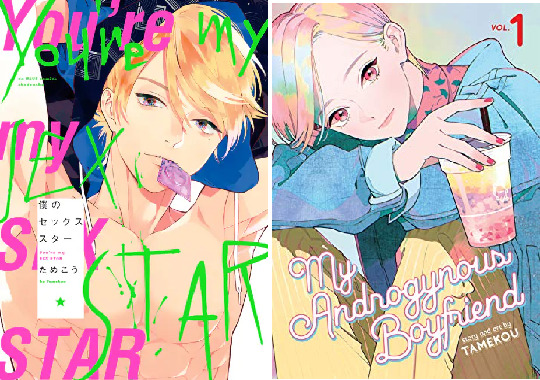
or Asumiko Nakamura

The curious case of Webtoons
With the digitalization of mangas, throught Renta and Lehzin, it has become easier (and more expensive) to access these stories. Korea makes and appearence with their webtoons. Through the lack of piracy protections and the majority of them being digital, manhwa (korean webtoons) sees a rise in popularity. Through the digital medium the influencee can be the influencer.
However, like many other East Asian countries they have consumed BL, without hearing about the conversations about BL. So they end up mantaining the older themes and stereotypes that newer BL is trying to leave behind. Therefore, we end up with a mix of old and new, ie:
Killing Stalking 2016
Cherry Blossoms After Winter 2017
Painter of The Night 2019
Additionally, it is also thanks to the easy access to internet that Omegaverse, with its higher dramatic stakes (that parallel hetero dynamics), enters the mangasphere in 2016. It has grown in popularity ever since.
With the Thai BL Boom of 2020, Japan rediscovers its own BL market and starts investing in it more. Which is why we get live action adaptations of BL manga that was popular years ago (Candy Color Paradox was a manga from 2010), the more recent ones (The End of the World With You) or new anime adaptations (Saezuru Tori wa Habatakanai in 2020).
more on this in my japanese live action BL post
What has it become now? is it BL? ML? or Seinen? Or is it all just gay manga?
It is clear that Shoujo manga (with BL, Josei and Seinen) is exploring queer themes such as gender and sexuality more and more. Japan is interested in this conversation, not only in manga (Genderless fashion). Which brings up the current question in BL studies: Does it make sense to keep these categories?
As a response to BL, ML (Male Love), which is made by gay men for gay men, started happening (around the 70s too). And Bara (gay manga porn) in response to Yaoi. However both gay men and women read BL and ML. We also see other themes being explored through BL, such as friendship (in BL Metamorphose), food (in Kinou Nani Tabeta), male relationships of all kinds (in Strange), and different queer views on life and its challenges (in Shimanami Tasogare). More and more what is LGBT and what is BL is merging, the line is blurred.
Conclusion
BL has been in my life for longer than it hasn't. It is through shoujo and BL that I have come to understand people and romance.
It is flawed, like everything else this life, but it's flourishing in many ways.
The genre feels old and new at the same time.
We can still find shounen ai/tanbi elements in more modern manga (All About J). Or the gay for you in a new light (Itoshi no Nekkoke). Or more educational manga on queer issues (My Brother’s Husband by Gengoroh Tagame). BL has around 50 years of existence but it is also being born anew in Thailand and Korea.
BL manga will continue to evolve in acordance to Japanese tastes, as it is still a local market. Hopefully the korean webtoons that get popular will be the more daring ones in their themes. Who knows where it will go from here? The only thing we know for sure is that it will continue to change. Isn't it exciting?
A post on the evolution of live action BL in Japan is coming, to complement this post. As well as a more detailed explanation of the Yaoi Debates and gay manga.
#history of bl#bl post series#I feel like I left too much stuff out#I hope it makes sense#honestly I would really recommend reading some of those manga#they're super interesting#soon it'll be 20 years since I started reading BL#my gosh#if theres anything anyone wants to know more about#I'd love to write more :)#yaoi manga#bl manga
664 notes
·
View notes
Text
Never forgiving the Hannibal Rising movie for not including the subplot about the paintings stolen from Lecter Castle during the war which are later found by Hannibal in a small art gallery in Paris. He recognizes one of them because years ago he had traced Mischa's hand with chalk on the back of one of the paintings :')
I will not mention that one of the people involved in the art theft erases the chalk drawing im order to ruin the sentimental value the painting held for young Hannibal.
#the plot is very very complex and i really recommend reading the book#hannibal#hannigram#hannibal lecter#will graham#hannibal nbc#hannibal rising
176 notes
·
View notes
Text
ok book club <3 what are we reading that’s actually good and would maybe fill the trc shaped hole in my soul???? and don’t say reread. unless you say reread the dreamer trilogy because i’m so close to giving into the urge.
please. please. give me your suggestions.
as a frame of reference here are non-trc books i love & would recommend (different content, same soul):
watch over me by nina lacour
in memoriam by alice winn
under the whispering door by tj klune
these violent delights by micah nemerever
the anthropocene reviewed by john green
summer sons by lee mandelo
a tale for the time being by ruth ozeki
i need an actual book club but tumblr took away my group chats :(
anyway love you please give me suggestions!!!!!
#i am also not really a fantasy person#BUT i like magical realism (i just don’t like the whole world building thing personally)#thank you#and maybe let’s all be best friends and read books together#trc#bookblr#book recommendations#book recs#the raven cycle#the dreamer trilogy#maggie stiefvater#nina lacour#alice winn#in memoriam#under the whispering door#these violent delights#micah nemerever#the anthropocene reviewed#summer sons#lee mandelo#a tale for the time being#ruth ozeki
176 notes
·
View notes
Text
something that kind of bothers me about modern feelings toward the epic of gilgamesh is how it's been COMPLETELY watered down to being "gay". Bear with me as I explain.

this is more of an extreme example, but I see this take all the time (not the yaoi part. the gay lover part). it's boiled down to the fact that it's gay over literally anything else in the epic. Gilgamesh's lament to Urshanabi about Enkidu's loss is overshadowed by the fact that Gilgamesh is mourning his gay lover. Gilgamesh is on a journey because he lost his gay lover. Gilgamesh and Enkidu were gay.
Now I understand that with a modern lens, people tend to lock on to how unabashedly Gilgamesh mourns Enkidu, because it's gay and because it's the oldest written epic in human history. People feel deeply connected to the idea that people like them have been around since the dawn of literature. But placing exclusive focus on the nature of the relationship as gay, rather than why the relationship or its loss was important, erases the story the epic is trying to tell.
The Epic of Gilgamesh is a story about love, yes, but it is not a love story. It's about the fear of death, coping with loss, and desperation to stave off the inevitable. It's about the bonds of friendship, about hardship, coming to terms personal change and losing pieces of yourself as you learn and grow. It is about consequences, arrogance, death, second chances, mourning, yearning, loving and LIVING. The Epic of Gilgamesh is about the entire human experience and one man's struggle to accept it. What does it mean to have lived? What does it mean to have loved, and lost? What does it mean to die, and to be remembered? What does it mean to be human?
It is perfectly okay to find appreciation for the Epic because of Gilgamesh and Enkidu's relationship. But also understand that the world's oldest story is not about two gay men who loved each other. It is a story about being alive.
TLDR;
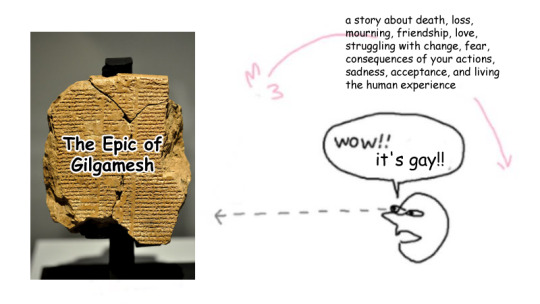
#the epic of gilgamesh#mesopotamia#sumerian#once again recommending that everyone read the epic of gilgamesh at least once because it really is a great story#gilgamesh and enkidu's relationship is first of all--a minor detail at best. homosexuality was normal in sumerian society#so it wouldn't have been unusual. in fact placing such intense focus on it is what's unusual#also they weren't even homosexual. they both also sleep with women. but the erasure of bisexuality is a completely different hornet's nest#i could also probably write a post about how watered down the whole ea-nasir thing is too#but hes so much of a meme i might as well try to convince a brick wall to get up and walk for all the good it'd do#anyway. im pretentious about this topic because i love it so fucking dearly. please recognize what it is youre appreciating
297 notes
·
View notes
Text
I'm sure I'm not the first person to talk about this, but I really want to give a big shout out to the @re-dracula team for making the Re: Dracula experience so accessible. And I'm not just talking about offering the whole thing for free, though that's still defintely an aspect of it.
For one thing, every podcast has a full and proper transcript. By "full and proper," I mean it not only covers the actual text being read, but who says what, what parts are said by which people, and crucially, describes all of the extra sound effects and musical cues they put in. Some transcripts are just a text dump, but this is a properly formatted script with all the bells and whistles.
Another thing is that each episode is prefaced by content warnings, where applicable. That is not something you can get from the original text, nor even Matt Kirkland's extra notes that come with each entry from previous years. Someone (or in all likelihood, multiple people) had to review the full manuscript for each podcast and figure out which themes required warnings. They then had to figure out how to make them specific enough to be useful but vague enough not to just be a flat out spoiler. That took extra effort and care, but it's going to make the whole thing so much more accessible to those who need them.
#re: dracula#they really didn't need to go that hard but they did#and I'm forever grateful for it#because I can comfortably recommend it to all of my followers who are interested in the story#which is not necessarily something I could do with the normal Dracula Daily#I mean can you imagine reading Swales' dialog with a screen reader
638 notes
·
View notes